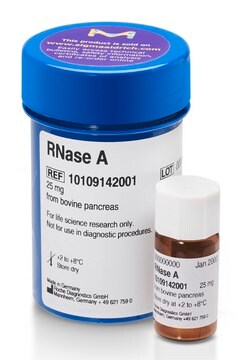05-507
Anti-Cdc25C Antibody, clone TC-15
clone TC-15, Upstate®, from mouse
Sign Into View Organizational & Contract Pricing
All Photos(1)
About This Item
UNSPSC Code:
12352203
eCl@ss:
32160702
NACRES:
NA.41
Recommended Products
biological source
mouse
antibody form
purified antibody
antibody product type
primary antibodies
clone
TC-15, monoclonal
species reactivity
mouse, human
manufacturer/tradename
Upstate®
technique(s)
immunocytochemistry: suitable
immunoprecipitation (IP): suitable
western blot: suitable
isotype
IgG1κ
NCBI accession no.
UniProt accession no.
shipped in
dry ice
target post-translational modification
unmodified
Gene Information
human ... CDC25C(995)
General description
The activity of cyclin-dependent kinases is regulated by their phosphorylation status, which is controlled by the antagonistic action of CDC25 phosphatases. Three CDC25 genes are present in human cells: CDC25A, CDC25B and CDC25C. CDC25C is a ~56 kDa dual specific protein phosphatase that controls entry into mitosis by regulating the dephosphorylation of the Cdk1/cyclin B complex. Phosphorylation of Cdc25C creates a binding site for 14-3-3 protein which inhibits Cdc25C. This prevents activation of the Cdk1/cyclin B complex and prevents mitotic entry. Cdc25C is phosphorylated by checkpoint kinases throughout interphase but becomes dephosphorylated during mitosis. Cdc25C is also regulated by p53 via a p53 response element in its promoter, and it is predominantly expressed in the G2 phase of the cell cycle.
Specificity
cdc25C
Immunogen
GST fusion-protein corresponding to residues 1-258 of human cdc25C. Epitope mapped to residues 222-246.
Application
Detect Cdc25C with Anti-Cdc25C Antibody, clone TC-15 (Mouse Monoclonal Antibody), that has been shown to work in IP, WB, ICC.
Research Category
Epigenetics & Nuclear Function
Epigenetics & Nuclear Function
Research Sub Category
Cell Cycle, DNA Replication & Repair
Cell Cycle, DNA Replication & Repair
Quality
routinely evaluated by immunoblot on HeLa nuclear extract
Target description
58kDa
Physical form
0.1M Tris-glycine, pH 7.4, 0.15M NaCl, 0.05% sodium azide before the addition of glycerol to 30%
Format: Purified
Protein G Chromatography
Storage and Stability
2 years at -20°C
Analysis Note
Control
HeLa nuclear extract
HeLa nuclear extract
Legal Information
UPSTATE is a registered trademark of Merck KGaA, Darmstadt, Germany
Disclaimer
Unless otherwise stated in our catalog or other company documentation accompanying the product(s), our products are intended for research use only and are not to be used for any other purpose, which includes but is not limited to, unauthorized commercial uses, in vitro diagnostic uses, ex vivo or in vivo therapeutic uses or any type of consumption or application to humans or animals.
Not finding the right product?
Try our Product Selector Tool.
Storage Class
10 - Combustible liquids
wgk_germany
WGK 1
Certificates of Analysis (COA)
Search for Certificates of Analysis (COA) by entering the products Lot/Batch Number. Lot and Batch Numbers can be found on a product’s label following the words ‘Lot’ or ‘Batch’.
Already Own This Product?
Find documentation for the products that you have recently purchased in the Document Library.
C Y Peng et al.
Science (New York, N.Y.), 277(5331), 1501-1505 (1997-09-05)
Human Cdc25C is a dual-specificity protein phosphatase that controls entry into mitosis by dephosphorylating the protein kinase Cdc2. Throughout interphase, but not in mitosis, Cdc25C was phosphorylated on serine-216 and bound to members of the highly conserved and ubiquitously expressed
Lei Guo et al.
Molecular pharmacology, 80(2), 321-327 (2011-05-07)
4-Hydroxy-5-methoxy-2,3-dihydro-1H-[1,3]benzodioxolo[5,6-c]pyrrolo[1,2-f]-phenanthridium chloride (NK314) is a benzo[c] phenanthridine alkaloid that inhibits topoisomerase IIα, leading to the generation of DNA double-strand breaks (DSBs) and activating the G(2) checkpoint pathway. The purpose of the present studies was to investigate the DNA intercalating properties
Arulkumar Nagappan et al.
Oncology letters, 12(2), 1394-1402 (2016-07-23)
Citrus platymamma hort. ex Tanaka belongs to the Rutaceae family and is widely used in folk medicines in Korea due to its anti-proliferative, anti-cancer, anti-oxidant, anti-inflammatory and anti-diabetic activities. However, the molecular mechanism of its anti-cancer effect is not well
Ji Hae Lee et al.
Cells, 8(2) (2019-02-14)
The CCAAT/enhancer-binding protein β (C/EBPβ) is a transcription factor that regulates cellular proliferation, differentiation, apoptosis and tumorigenesis. Although the pro-oncogenic roles of C/EBPβ have been implicated in various human cancers, how it contributes to tumorigenesis or tumor progression has not
Xiaojun Liu et al.
Cancer research, 65(15), 6874-6881 (2005-08-03)
2'-C-cyano-2'-deoxy-1-beta-D-arabino-pentofuranosylcytosine (CNDAC) is a nucleoside analogue with a novel mechanism of action that is currently being evaluated in clinical trials. Incorporation of CNDAC triphosphate into DNA and extension during replication leads to single-strand breaks directly caused by beta-elimination. These breaks
Our team of scientists has experience in all areas of research including Life Science, Material Science, Chemical Synthesis, Chromatography, Analytical and many others.
Contact Technical Service